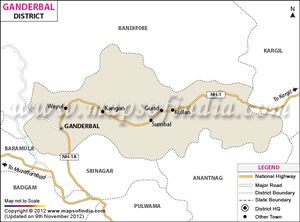Sumbal

Sumbal(सुमबल) is an ancient village in Ganderbal district of Jammu and Kashmir, India. Parihasapura (परिहासपुर) was an ancient city built by the Lalitaditya in Jammu and Kashmir. It has been identified with present Sumbal[1] in Ganderbal district of Jammu and Kashmir,
Location
History
Kasmir visit of Xuanzang in 631 AD
Alexander Cunningham[2] Parihasapura was built by the great Raja Lalitaditya,[3] who reigned from A.D. 723 to 760. It was situated on the right, or eastern bank of the Behat, near the present village of Sumbal. There are still many traces of walls and broken stones on the neighbouring mounds, which show that a city must once have existed on this spot ; but the only considerable remains are a bridge which spans the Behat, and a canal which leads direct towards Supur, to avoid the tedious passage by the river through the Wular Lake. As Parihasapura is not mentioned again in the native chronicle, it must have been neglected very soon after its founder's death. His own grandson, Jayapida, built a new capital named Jayapura, in the midst of a lake, with a citadel, which he named Sri-dwaravati, but which the people always called the " Inner Fort."[4] The position of this place is not known, but I believe that it stood on the left bank of the Behat, immediately opposite to Parihasapura, where a village named Antar-kot, or the " Inner Fort,"
[p.102]: exists to this day. The final destruction of this city is attributed by the people to Sangkara Varmma, who reigned from A.D. 883 to 901. He is said to have removed the stones to his own new city of Sangharapura, which still exists as Pathan, 7 miles to the south-west of the Sumbal bridge. The great temple at Parihasa was destroyed by the bigoted Sikandar, who reigned from 1389 to 1413, A.D. Of this temple a curious story is told by the Muhammadan historians. Speaking of Parispur, Abul Fazl[5] says, "here stood a lofty idolatrous temple which was destroyed by Sikandar. In the ruins was found a plate of copper with an inscription in the Indian language purporting that after the expiration of 1100 years the temple would be destroyed by a person named Sikandar." The same story is told by Ferishta,[6] with the addition of the name of the Raja, whom the translator calls Balnat, which is probably a mistake for Laldit, the usual contracted form of Lalitaditya among the Kashmiris. As the difference of time between this prince and Sikandar is barely 700 years, it is strange that the tradition should preserve a date which is so much at variance with the chronology of their own native chronicles.
References
- ↑ Alexander Cunningham: The Ancient Geography of India/Kingdom of Kashmir, p.101-1-2
- ↑ The Ancient Geography of India/Kingdom of Kashmir,pp.101-102
- ↑ ' Raja Tarangini,' iv. 194
- ↑ Ibid., iv. 505, 510.
- ↑ ' Ayin Akbari," ii. 135.
- ↑ Briggs's ' Ferishta,' iv. 465.